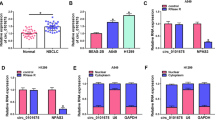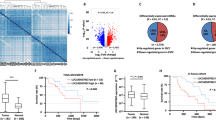Abstract
Background
The dysregulation of LncRNAs is related to the malignant progression of many cancers.
Objective
The study aimed to investigate the expression and the biological role of LncSNHG3 in hepatocellular carcinoma (HCC).
Methods
The TCGA data of the LncSNHG3 in HCC were analyzed. The expression in HCC cell lines was detected by qRT-PCR. Proliferation, migration, and invasion of HepG2 and Huh7 were examined by cell counting kit-8, colony formation, transwell assays, and wound healing assays. At the same time, the interactions among LncSNHG3, miR-152-3p, and JAK1 were confirmed by dual-luciferase reporter assay, RNA immunoprecipitation, subcellular distribution. Xenograft tumor-bearing mice models were used to measure the effect of LncSNHG3 on the growth of HCC in vivo. The apoptosis and epithelial mesenchymal transition (EMT)-associated proteins were checked by WB and IHC.
Results
LncSNHG3 was overexpressed in HCC tissues and cell lines. In addition, it is correlated with the tumor stage and survival time of HCC patients. Down-regulated LncSNHG3 could significantly suppress the EMT progression of HCC in vivo and in vitro. LncSNHG3 could promote the JAK1 expression by sponging miR-152-3p.
Conclusions
LncSNHG3 acted as an oncogene and promoted the EMT procession in HCC by binding miR-152-3p and promoting JAK1 expression. Predictably, LncSNHG3 was used as a potential marker and will be used as a novel therapy target for HCC in the future.






Similar content being viewed by others
Availability of data and material
The data are available from the corresponding author on reasonable request.
References
Bhan A, Soleimani M, Mandal SS (2017) Long noncoding RNA and cancer: a new paradigm. Cancer Res 77:3965–3981
Cao Y, Zhang F, Wang H, Bi C, Cui J, Liu F, Pan H (2021) LncRNA MALAT1 mediates doxorubicin resistance of hepatocellular carcinoma by regulating miR-3129-5p/Nova1 axis. Mol Cell Biochem 476:279–292
Ding D, Li C, Zhao T, Li D, Yang L, Zhang B (2018) LncRNA H19/miR-29b-3p/PGRN axis promoted epithelial-mesenchymal transition of colorectal cancer cells by acting on wnt signaling. Mol Cells 41:423–435
Ferlay J, Soerjomataram I, Dikshit R, Eser S, Mathers C, Rebelo M, Parkin DM, Forman D, Bray F (2015) Cancer incidence and mortality worldwide: sources, methods and major patterns in GLOBOCAN 2012. Int J Cancer 136:E359–E386
Forner A, Reig M, Bruix J (2018) Hepatocellular carcinoma. Lancet 391:1301–1314
Guttman M, Rinn JL (2012) Modular regulatory principles of large non-coding RNAs. Nature 482:339–346
Jarroux J, Morillon A, Pinskaya M (2017) History, discovery, and classification of lncRNAs. Adv Exp Med Biol 1008:1–46
Llovet JM, Montal R, Sia D, Finn RS (2018) Molecular therapies and precision medicine for hepatocellular carcinoma. Nat Rev Clin Oncol 15:599–616
Lou J, Yan W, Li QY, Zhu AK, Tan BQ, Dong R, Zou XZ, Liu T (2021) LncRNA MEG8 plays an oncogenic role in hepatocellular carcinoma progression through miR-367-3p/14-3-3zeta/TGFbetaR1 axis. Neoplasma 68:273–282
Morse MA, Sun W, Kim R, He AR, Abada PB, Mynderse M, Finn RS (2019) The role of angiogenesis in hepatocellular carcinoma. Clin Cancer Res 25:912–920
Santucci R, Sinibaldi F, Cozza P, Polticelli F, Fiorucci L (2019) Cytochrome c: An extreme multifunctional protein with a key role in cell fate. Int J Biol Macromol 136:1237–1246
Statello L, Guo CJ, Chen LL, Huarte M (2021) Gene regulation by long non-coding RNAs and its biological functions. Nat Rev Mol Cell Biol 22:96–118
Subramaniam A, Shanmugam MK, Ong TH, Li F, Perumal E, Chen L, Vali S, Abbasi T, Kapoor S, Ahn KS et al (2013) Emodin inhibits growth and induces apoptosis in an orthotopic hepatocellular carcinoma model by blocking activation of STAT3. Br J Pharmacol 170:807–821
Tao H, Li J, Liu J, Yuan T, Zhang E, Liang H, Huang Z (2021) Construction of a ceRNA network and a prognostic lncRNA signature associated with vascular invasion in hepatocellular carcinoma based on weighted gene co-expression network analysis. J Cancer 12:3754–3768
Wan T, Zheng J, Yao R, Yang S, Zheng W, Zhou P (2021) LncRNA DDX11-AS1 accelerates hepatocellular carcinoma progression via the miR-195-5p/MACC1 pathway. Ann Hepatol 20:100258
Weng W, Zhang Z, Huang W, Xu X, Wu B, Ye T, Shan Y, Shi K, Lin Z (2020) Identification of a competing endogenous RNA network associated with prognosis of pancreatic adenocarcinoma. Cancer Cell Int 20:231
Wu J, Liu L, Jin H, Li Q, Wang S, Peng B (2019) LncSNHG3/miR-139-5p/BMI1 axis regulates proliferation, migration, and invasion in hepatocellular carcinoma. Onco Targets Ther 12:6623–6638
Yin T, Liu MM, Jin RT, Kong J, Wang SH, Sun WB (2019) miR-152-3p Modulates hepatic carcinogenesis by targeting cyclin-dependent kinase 8. Pathol Res Pract 215:152406
Zhang T, Cao C, Wu D, Liu L (2016) SNHG3 correlates with malignant status and poor prognosis in hepatocellular carcinoma. Tumour Biol 37:2379–2385
Zhang PF, Wang F, Wu J, Wu Y, Huang W, Liu D, Huang XY, Zhang XM, Ke AW (2019) LncRNA SNHG3 induces EMT and sorafenib resistance by modulating the miR-128/CD151 pathway in hepatocellular carcinoma. J Cell Physiol 234:2788–2794
Zhang J, Kodali S, Chen M, Wang J (2020) Maintenance of germinal center B cells by caspase-9 through promotion of apoptosis and inhibition of necroptosis. J Immunol 205:113–120
Zhu GJ, Song PP, Zhou H, Shen XH, Wang JG, Ma XF, Gu YJ, Liu DD, Feng AN, Qian XY et al (2018) Role of epithelial-mesenchymal transition markers E-cadherin, N-cadherin, beta-catenin and ZEB2 in laryngeal squamous cell carcinoma. Oncol Lett 15:3472–3481
Acknowledgements
The study was supported by Natural Science Foundation of China (81860534); Inner Mongolia autonomous region science and technology planning project (2019GG039/086/107, 2021GG0167); Zhi Yuan Talent Projects of Inner Mongolia Medical University (ZY0202011); Natural Science Foundation of Inner Mongolia (2021MS08152).
Author information
Authors and Affiliations
Contributions
Haiping Zhao and Hao Yang designed the study. Hong Li, Yu Wu and Runmei Wang performed the experiments and drafted the manuscript. Junmei Guo, Qin Yu and Lihe Zhang analyzed the data. All authors read and approved the final manuscript.
Corresponding authors
Ethics declarations
Conflict of interest
Hong Li, Yu Wu, Runmei Wang, Junmei Guo, Qin Yu, Lihe Zhang, Haiping Zhao and Hao Yang declare that there are no conflicts of interest.
Ethics approval
The animal experiments were approved by the Inner Mongolia Medical University Animal Ethics Committee and performed according to the Guide for the Care and Use of Laboratory Animals.
Additional information
Publisher’s Note
Springer Nature remains neutral with regard to jurisdictional claims in published maps and institutional affiliations.
Rights and permissions
About this article
Cite this article
Li, H., Wu, Y., Wang, R. et al. LncSNHG3 promotes hepatocellular carcinoma epithelial mesenchymal transition progression through the miR-152-3p/JAK1 pathway. Genes Genom 44, 133–144 (2022). https://doi.org/10.1007/s13258-021-01185-x
Received:
Accepted:
Published:
Issue Date:
DOI: https://doi.org/10.1007/s13258-021-01185-x




